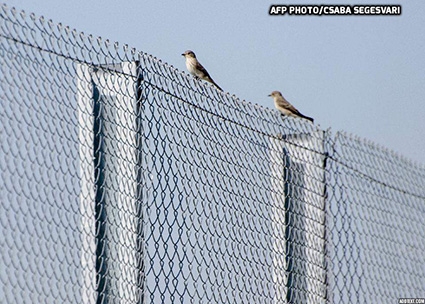Estonia to Build a Fence against Russia
The Estonian government has declared its plans to build a fence along its Eastern border with Russia to increase security and protect the EU’s passport-free Schengen zone.
According to the BBC, construction of the fence, planned to be about 110km (70 miles) long and 2.5m (8ft) high, is set to start in 2018. It is expected to cost about 71m Euros (Ј52m; $80m).
Notably, the plans come amid heightened tensions between Russia and the West regarding the Ukraine conflict. Simultaneously, Europe is also struggling with an influx of migrants.
“The aim of the construction is to cover the land border with 100%, around-the-clock technical surveillance to create ideal conditions for border guarding and to ensure the security of Estonia and the Schengen area,” interior ministry spokesman Toomas Viks told AFP news agency.
According to Viks, information gathered could be used to investigate illegal border crossing, smuggling and human trafficking. As Estonian media reports, the fence would only cover just over a third of Estonia’s 294km (183 miles) border with Russia as much of it is covered by water.
Estonia is part of the EU as well as a sharer of the Schengen area enabling passport-free access.
To look back, Hungary, which has shared the Soviet past too, has already started building a 175km-long fence along its border with Serbia to try to keep migrants out as thousands of people are reported to be crossing into the country every day and heading North into Europe, Germany in particular.
However, Russian government representatives say that the fence building is directly aimed at limiting Russians in the area. Konstantin Kosachev, deputy head of the Russian parliament’s foreign affairs committee, has condemned the plan for the fence.
According to him, he said Estonia did not face the same migrants challenge as other EU countries and that the aim instead was ideological - to depict Russia as a threat to Europe.
It is also supported idea that Estonia in the public, which joined NATO and the EU in 2004, tries to preempt Russia’s probable invasion or other sorts of hybrid warfare in the country, as it has already experienced such behaviors of its closest neighbor. Moreover, It is strategically believed that if the Russian government is not deterred in Ukraine, their next move will be to Georgia and subsequently, the Eastern European countries, which have lived their forced lives in the USSR.
Some similar historical facts by BBC:
- Israel began building a barrier in and around the occupied West Bank in 2002: 720km planned by completion.
- India has fenced much of the 740km Line of Control (LoC) that divides Indian and Pakistani-administered Kashmir.
- The Demilitarised Zone (DMZ) between North and South Korea created in 1953 heavily guarded on both sides: 250km long and about 4km wide.
- Saudi Arabia is building a fence along its border with Yemen: 1,800km.
- The Berlin Wall (20th Century) divided Berlin from 1961 to 1989: 155km.
- Hadrian’s Wall (2nd Century), divided the Romans in England from Scotland: 117.5km.
- The Great Wall of China (began in 5th Century BC), a series of walls protecting China’s northern border: 21,196km, built up over several centuries.
Can Georgia share some of its partners’ experience regarding its security? Will the fence help Estonia increase its security?
Steven Jones












